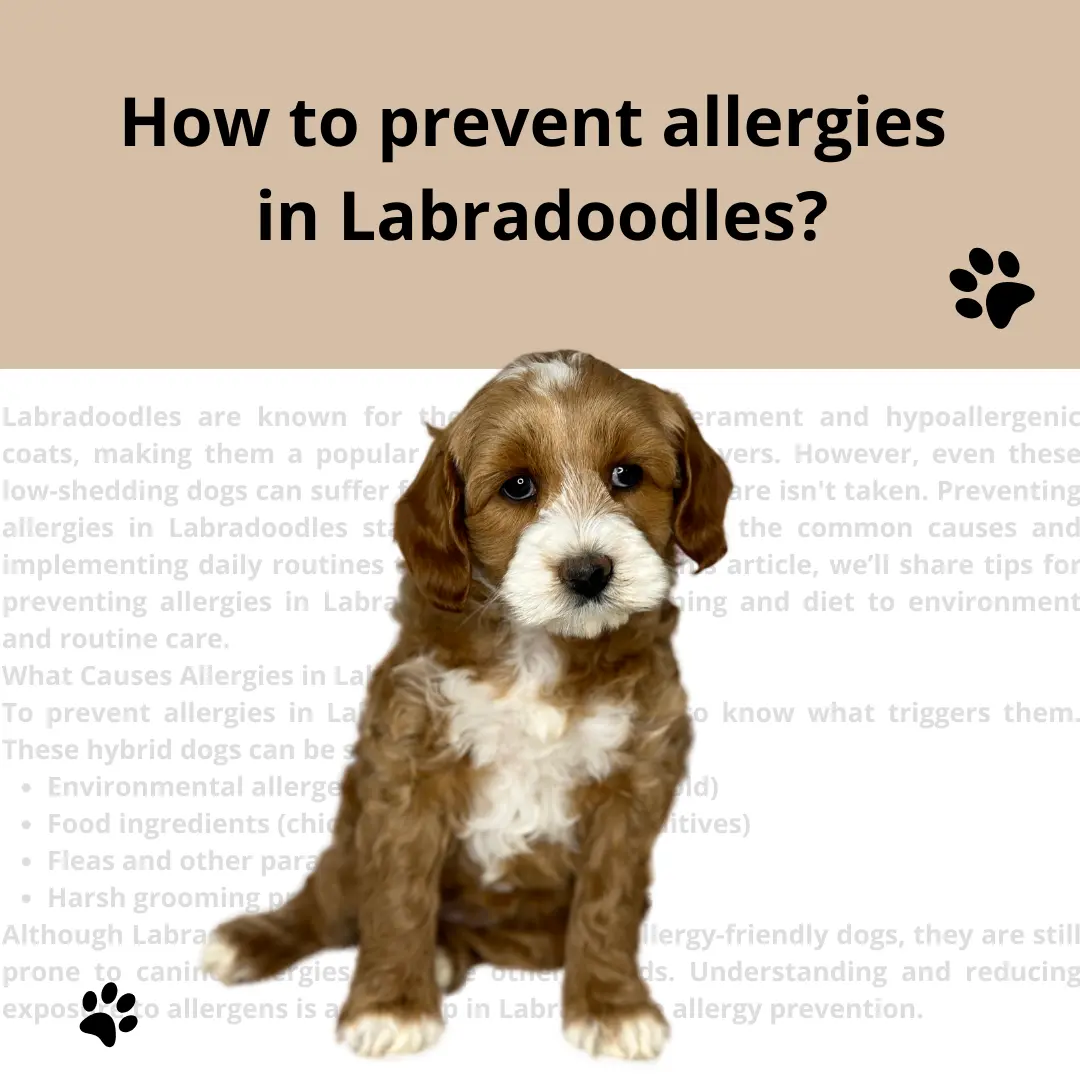Labradoodles are known for their friendly temperament and hypoallergenic coats, making them a popular choice among dog lovers. However, even these low-shedding dogs can suffer from allergies if proper care isn’t taken. Preventing allergies in Labradoodles starts with understanding the common causes and implementing daily routines to minimize risk. In this article, we’ll share tips for preventing allergies in Labradoodles, from grooming and diet to environment and routine care.
What Causes Allergies in Labradoodles?
To prevent allergies in Labradoodles, it’s crucial to know what triggers them. These hybrid dogs can be sensitive to:
- Environmental allergens (pollen, dust mites, mold)
- Food ingredients (chicken, grains, artificial additives)
- Fleas and other parasites
- Harsh grooming products or infrequent baths
Although Labradoodles are often marketed as allergy-friendly dogs, they are still prone to canine allergies just like other breeds. Understanding and reducing exposure to allergens is a key step in Labradoodle allergy prevention.
Regular Grooming: First Line of Defense
One of the most effective ways to prevent allergies in Labradoodles is maintaining a consistent grooming routine. Their curly or wavy coats can trap dust, pollen, and dander, contributing to skin irritation and allergic reactions.
- Brush your Labradoodle’s coat 3–4 times a week to remove trapped allergens and prevent matting.
- Bathe your dog every 4–6 weeks using a gentle, hypoallergenic dog shampoo.
- Keep ears clean and dry, as Labradoodles are prone to ear infections linked to allergies.
- Schedule regular visits to a professional groomer familiar with Labradoodle grooming needs.
Proper grooming helps reduce contact with environmental irritants, making it an essential part of allergy prevention in Labradoodles.
Choosing the Right Diet
Diet plays a huge role in preventing allergies in any dog, and Labradoodles are no exception. Food allergies are one of the most common causes of chronic itching, ear infections, and gastrointestinal issues.
Tips for allergy-free feeding:
- Choose high-quality dog food with limited ingredients to identify any potential allergens.
- Consider switching to grain-free or novel protein diets if you suspect food intolerance.
- Avoid foods with artificial colors, flavors, or preservatives.
- If needed, consult your vet about trying an elimination diet to isolate specific allergens.
Supporting your Labradoodle’s immune system with omega-3 fatty acids and probiotics can also help in managing and preventing food-related allergies.
Keep Your Labradoodle’s Environment Allergen-Free
Minimizing exposure to environmental allergens is just as important as grooming and diet. Even if your Labradoodle is not naturally allergy-prone, poor environmental conditions can trigger symptoms.
How to maintain an allergy-safe environment:
- Vacuum and dust your home regularly to remove pollen and pet dander.
- Use air purifiers with HEPA filters to trap airborne allergens.
- Wash your dog’s bedding weekly with fragrance-free detergent.
- Limit outdoor exposure during high pollen seasons.
- Rinse your dog’s paws and coat after walks to remove allergens.
Creating a clean and allergen-free home is a fundamental part of Labradoodle allergy care.
Flea and Parasite Control
Parasites like fleas don’t just cause itching — they can also lead to severe allergic reactions known as flea allergy dermatitis. For effective allergy prevention in Labradoodles, consistent parasite control is essential.
- Use veterinarian-approved flea preventatives year-round.
- Check your Labradoodle’s skin regularly for signs of parasites.
- Treat your home and yard if there’s an infestation.
Preventing fleas not only keeps your Labradoodle comfortable but also reduces the risk of secondary skin infections and allergies.
Recognizing Early Allergy Symptoms
Even with the best prevention, some Labradoodles may still develop mild allergic reactions. Early detection can prevent the issue from worsening.
Watch for signs such as:
- Excessive scratching or licking
- Red, inflamed, or flaky skin
- Recurring ear infections
- Watery eyes or sneezing
- Gastrointestinal issues (vomiting, diarrhea)
If you notice these symptoms, consult your veterinarian. Early treatment and allergy testing can help identify the cause and prevent future flare-ups in your Labradoodle.
Labradoodle Allergy Prevention is an Ongoing Effort
Every Labradoodle is unique, and preventing allergies is not a one-size-fits-all approach. It requires regular care, observation, and adjustments to lifestyle and routines. Whether it’s through proper grooming, a carefully chosen diet, or an allergy-conscious home environment, the goal is to create conditions where your Labradoodle thrives.
By following these tips for allergy prevention in Labradoodles, you’ll reduce the risk of discomfort and help your dog enjoy a healthier, happier life.
Conclusion
Preventing allergies in Labradoodles involves a mix of grooming routines, mindful feeding, and environmental awareness. While Labradoodles are often considered hypoallergenic, they still need special care to stay allergy-free. If you’re proactive and attentive, your Labradoodle can enjoy a life free from the common issues that allergies bring. Remember: consistent care is the best way to protect your pet’s health and happiness.



